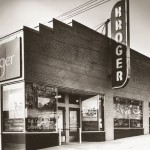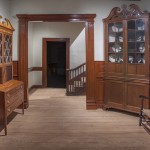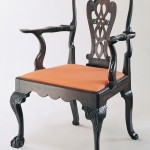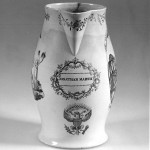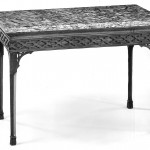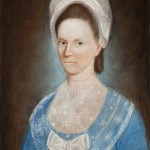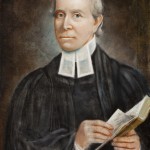Treasures of the Edenton Rooms Revisited, Happy 50th Birthday MESDA
By Jim Melchor & Tom Newbern
Editor’s Note: To enlarge the figures in the body of this article, simply click on them once. To close the enlargement, click on the X in the top right corner. For even higher resolution enlargements for each figure, go to the photo gallery at the end of the article and click once on the desired figure.
On the outside chance that there is someone who does not know about MESDA, let us begin with two simple questions. What is MESDA, and where is MESDA? MESDA, The Museum of Early Southern Decorative Arts, first and foremost is a major museum dedicated to the study, preservation, collection, and display of the decorative arts made and used in the American South generally prior to 1840. MESDA is part of Old Salem Museums and Gardens, and it is located on the southern end of the historic area in Winston-Salem, NC. MESDA’s expansive collection is displayed in an assortment of permanent and changing galleries, period rooms removed from derelict or threatened southern houses, and reproduction rooms based on rooms in period southern houses. In addition to its exhibits, MESDA is the preeminent research center for the study of southern decorative arts with literally tens of thousands of files, images, and documents. MESDA also publishes the Journal of Early Southern Decorative Arts where articles are presented on all aspects of southern material culture. MESDA is dynamic, and we strongly encourage you to visit its website, http://www.mesda.org often, or better still, visit MESDA in person.
MESDA did not just happen. It was the brainchild of our dear friend, Frank Horton, and his mother, Theo Taliaferro (Fig. 1, Frank Horton and Theo Taliaferro). Frank’s passion for southern antiques developed at an early age as his mother was an antiques dealer in Virginia and North Carolina. In addition to sales of antiques, Frank and his mother personally collected important southern antiques at a time when such things were not appreciated as much as they are today. Also, the two were seriously interested in researching and understanding the material. Frank devoted his life to preserving southern material culture. He was instrumental in and oversaw the restoration of Old Salem. In 1960, the old Kroger grocery store at the southern end of Old Salem was purchased and converted into a suitable museum building. With the loan of much of Frank and Mrs. Taliaferro’s collections of southern antiques, MESDA opened in 1965 (Fig. 2, Kroger store)(Fig. 3, MESDA in late1960s). Over the past 50 years, MESDA has grown considerably and is now housed with the Old Salem Museums and Gardens Research Center and Library in the new Frank L. Horton Museum Center that is a vastly expanded and metamorphosed Kroger store (Fig. 4, Frank L. Horton Museum Center).
Frank passed away in 2004. Those of us who knew him well would recognize Frank doing that which he loved best, research (Fig. 5, Frank L. Horton, 1918-2004). Luke Beckerdite wrote a fitting tribute to Frank in American Furniture 2006. MESDA is now in the capable hands of our friend, Robert Leath, and his dedicated colleagues.
As mentioned, MESDA displays part of its extensive collection in period rooms from southern houses. In this article, we will focus on the Edenton Rooms and the decorative arts from Edenton, NC, and the surrounding areas, contained therein.
MESDA’s Edenton Rooms consist of the period interiors that were originally in the parlor, passage, and stair passage of the circa 1766 George Blair House. This unusual T-shaped house formerly stood on Eden Street in Edenton, and it is shown on the 1769 Sauthier map. The Blair House was extensively altered in the mid to late nineteenth century to reflect the Victorian taste of the time (Fig. 6, Modified George Blair House). The house was dismantled in 1957 to make room for a church parking lot. In 1988, Frank Horton did a first-floor plan sketch (Fig. 7, First-floor plan view of Blair House). In his sketch, Horton refers to the passages in the modern terminology as halls. North Carolina Restoration Specialist, Reid Thomas, in his 2007 unpublished study for MESDA, reviewed the documentary photographs of the Blair House and examined the period interiors now installed in MESDA. The purpose of this review was to determine, as well as possible, the original interior and exterior appearances of the house. Thomas concluded that the house was originally a T-shaped, gambrel-roof structure.
The George Blair House interiors were installed as period rooms in MESDA, were repainted, and were furnished with period furniture from the South and with complimentary accessories (Fig. 8, Edenton Parlor, early view). Throughout the twentieth century, museums presented their period rooms, whether installed in the museums or remaining in period museum houses, how the experts thought they should look. However, these rooms, though beautiful, often were way over furnished, cluttered, and painted in improper colors. With major advances in research and analytical tools, many museums have taken a fresh look at their period rooms. Notably in the South, Colonial Williamsburg took the lead with its entire Historic Area, and MESDA has followed suit. The Edenton Rooms are a prime example of the transformation from simply beautiful rooms, through several iterations over the years, to the now less cluttered, more period correct, but still beautiful, rooms (Figs. 9a, 9b, 9c, & 9d, Edenton Parlor now) (Fig. 10, Edenton Passage) (Fig. 11, Edenton Passage and Stair Passage). The decorative arts, including furniture, presented in the Edenton Rooms provide a sampling from Edenton proper and from surrounding areas in keeping with those that would have been found in various prosperous urban settings in eighteenth and early nineteenth-century coastal North Carolina. The rooms, however, are not attempts at vignettes of everyday life in Edenton. The present color schemes of the Edenton Rooms replicate their original appearances and are based on modern, scientific, paint analyses. (Note there are several other articles on this website, www.ehcnc.org/decorative-arts/, discussing scientific paint analyses).
Remember, the Edenton Rooms now are presented as both period living areas and as museum galleries complete with proper lighting and highlighted display areas (e.g. the chair in the Edenton Parlor, see Fig. 9a). These changes were not simply a facelift. Rather, they resulted from time-consuming, costly, comprehensive research on and analyses of the rooms themselves, the furniture, the paintings, and the lives of the people in eighteenth and early nineteenth-century, coastal North Carolina. The final product is a clean presentation of the rooms, tastefully displaying the local treasures they contain.
Next, we will take a “virtual tour” of MESDA’s Edenton Rooms, themselves southern architectural treasures, and look at the individual treasures within each room. Beginning in the Edenton Parlor (see Fig. 9a), the focal point is the armchair displayed in the center of this view of the room. This chair (Fig. 12, Edenton armchair), initially thought by some to be a Norfolk, VA, product, has since been recognized as Edenton. It and several others have Edenton-area family histories. More compelling still, these chairs have carving details directly related to the stair spandrels in MESDA’s Edenton Passage and Stair Passage from the George Blair House (see Fig. 11) (Fig. 13, Blair House stair spandrel). This chair descended in the Benjamin Harvey family of Perquimans County, NC.
The demilune table to the left of the fireplace is by William Seay of Bertie County, NC (Fig. 14, Seay table). He is also known as the “WH Cabinetmaker”. This table descended in the family of David Clark of Halifax County, NC.
The Liverpool jug resting on the Seay table was made for and owned by Jonathan Marsh of Bath, NC (Figs. 15a, 15b, 15c, and 15d, Marsh Liverpool jug). Personalized period ceramics are extremely rare in America and especially in the South.
The slab sideboard table to the right of the fireplace is attributed to New Bern, NC (Fig. 16, New Bern slab table). The two portraits hanging above the two tables on either side of the fireplace are of Mr. Samuel Carr and Mrs. Elizabeth (Riddick) Carr of Suffolk, VA. John Durand painted these two portraits (Figs. 17a & 17b, Durand portraits of Mr. and Mrs. Samuel Carr) These Durand portraits are on loan to MESDA from the Colonial Williamsburg Foundation. MESDA and Colonial Williamsburg often collaborate and share pieces in their collections. The major exhibit at the Art Museums of Colonial Williamsburg, A Rich and Varied Culture: The Material World of The Early South, is a prime example of this arrangement. This exhibit is a must see for those who care about southern material culture. For details, go to: http://www.visitwilliamsburg.com/events/a-rich-and-varied-culture-the-material-world-of-the-early-south/.
In the next view of the Edenton Parlor (see Fig 9b), we are presented with three furniture treasures by cabinetmaker, Thomas White, of Perquimans County: a corner or smoking chair (Fig. 18, White corner chair), White’s iconic desk with a central or fifth foot (Fig. 19, White desk), and a side chair (Fig. 20, White side chair). The corner chair descended in the Cheshire family of Chowan County, NC. Thomas Newby of Perquimans County originally owned the White desk, and the side chair originally belonged to the Reverend and Mrs. Charles Pettigrew, also of Perquimans County. The map hanging over the White desk is A General Chart of the Western Ocean by John Seller, ca. 1743-65, first published in 1721 (Fig. 21, Seller map). What makes this particular map so important is that someone during the period plotted an actual southern voyage from England, down the African coast, across the Atlantic, up the Caribbean islands to North Carolina. As with the previously mentioned Durand portraits, this map also is on loan to MESDA from Colonial Williamsburg.
In the Edenton Parlor view in Fig. 9c, the china press is by the Sharrock family of Northampton and Bertie Counties, NC (Fig. 22, Sharrock china press). Members of the Sharrock family later settled in Halifax and Franklin Counties, NC. Similar forms of this press are found in these and adjoining counties. This china press descended in the family of Hugh Johnston of Kinderhook Plantation in Warren County, NC. A recently discovered desk that can be firmly attributed to Thomas Sharrock, Sr., probably dating from the 1790’s, displays feet exactly matching the feet on this press as well as on a related press in the collection of the DAR Museum in Washington, DC. The two side chairs on either side of the china press were made in Edenton but with a likely Norfolk influence (Fig. 23, Edenton side chair). A matching, though less ornate, version of the brackets present on these chairs is found on a ca. 1760, three-drawer, Norfolk, dressing table, as well as on several pieces of furniture constructed in North Carolina’s Roanoke River Basin. Based on recent research by Robert Leath, these chairs descended in the family of John Mushro Roberts in Edenton and New Bern with direct family links back to Edenton cabinetmakers, Samuel Black and William McDonald. Keep in mind, the Sharrocks were from Norfolk, and there was, and still is, extensive, close, cultural interchange between southeastern Virginia and northeastern North Carolina. That is why the furniture of these two regions is often so closely related.
In the final view of the Edenton Parlor (see Fig. 9d), we have two fine examples of Edenton tables (Fig. 24, Edenton gaming table) (Fig. 25, Edenton writing table). These two formal tables have Edenton carving details matching the stair spandrels from the George Blair House (see Fig. 13 and related discussion) now installed in MESDA’s Edenton Rooms. Willie Jones of Halifax County originally owned the gaming table. This writing table was found in Bertie County. The two portraits hanging above the gaming table are of the Reverend Charles Pettigrew and his wife, Mary (Blount) Pettigrew who lived at Belgrade on Harvey’s Neck in Perquimans County. These pastel portraits are by Edenton artist, William Joseph Williams (Figs. 26a, 26b, 27a, and 27b, Pettigrew portraits, front and back views). As noted above, the Pettigrews owned the Thomas White side chair (see Fig. 20). The portrait above the Edenton writing table is of Priscilla (Hill) Montfort of Halifax County (Fig. 28, Priscilla Montfort portrait). This portrait is attributed to artist, John Durand. Priscilla Montfort was the mother-in-law of Willie Jones, the owner of the Edenton gaming table.
Next, we move into the Edenton Passage (see Fig. 10). The blue corner cupboard belonged to John Brown, a prominent planter, who lived at Oakland in Bladen County, NC (Figs. 29a, 29b, and 29c, John Brown corner cupboard). The maker of this cupboard is not known, but it is one of only two known painted pieces by this craftsman. According to MESDA’s files, John Brown’s father, Col. Thomas Brown, served with distinction in the Revolutionary War, as the ranking member of the Bladen County militia, and in 1781, shortly before the American victory at Yorktown, he spearheaded the British defeat at the Battle of Elizabethtown. Soon thereafter, he was promoted to Major General and began constructing his plantation house at Oakland. The small portrait hanging to the right of the corner cupboard is of Adam Boyd of Wilmington, NC (Fig. 30, Boyd portrait). Boyd published the Cape Fear Mercury newspaper and served in the American Revolution. The artist is unknown.
The fall-front desk opposite the John Brown corner cupboard is signed and labeled by cabinetmaker, Lewis Bond, of Greenville, Pitt County, NC (Fig. 31, Bond desk). Hanging above this desk is a portrait, by an unknown artist, of Wilson B. Hodges of Beaufort County, NC (Figs. 32a & 32b, Hodges portrait, front and back views).
In the Edenton Passage facing the Stair Passage (see Fig. 11), the desk and bookcase to the left is attributed to Wilmington based on similarities with two desks with Wilmington histories (Fig. 33, Wilmington desk and bookcase). This unusual piece also shares design elements with other local pieces and with New England work as well as with Norfolk work. Norfolk cabinetmaking was influenced to a degree by imports from New England through the extensive coastwise trade. In turn, Norfolk’s cabinetmaking and cabinetmakers were no strangers in eastern North Carolina. This intermingling of styles from various regions has resulted in an unusual, if not unique, hybrid piece with its own rather pleasing aesthetics. Signatures on small interior drawers place this piece in Bladen County, on the Cape Fear River close to Wilmington, in the late nineteenth century.
On the opposite wall facing the Wilmington desk and bookcase is a well-turned, walnut, ladder-back chair attributed to coastal North Carolina (Fig. 34, Ladder-back chair). Hanging above this chair is a naive landscape painted by Martha (Riddick) Pruden of Hertford County, NC (Fig. 35, Pruden landscape). Martha, the daughter of James Riddick, was born in 1813 and grew up on her father’s plantation just west of the present town of Ahoskie, NC. She married William Dorsey Pruden, the nephew of her neighbor Michael Eley Newsome. The Prudens purchased and resided at a valuable plantation near the Chowan River east of Harrellsville, NC in southeastern Hertford County. This painting descended to Martha’s daughter, Aurelia A. Pruden. She was born in 1837 and married Horatio B. Hayes of Colerain, NC.
Finally, William Seay, the “WH Cabinetmaker” of Bertie County made this iconic “WH” corner cupboard for Whitmell Hill, thus the initials, “WH” on the pediment (Fig. 36a, Seay “WH” corner cupboard) (Fig 36b, Pediment of Seay corner cupboard showing “WH” in the roundel). Hill was an extremely wealthy planter and North Carolina statesman. He was born in Bertie County, had extensive land and slave holdings in Martin, Halifax, and Bertie Counties, and lived with his wife, Winifred (Blount) Hill, at Hill’s Ferry in what is now Halifax County. Hill commissioned a number of pieces for himself and his family from Seay, most of which, but not all, bore his initials, “WH”. This particular cupboard has a history of descent in the Cotton family of Scotland Neck in Halifax County. Whitmell Hill commissioned this corner cupboard for one of his children. The cupboard likely entered the Cotton line sometime between ca. 1800 and 1815 through an estate purchase upon the death of one of Hill’s children. Whitmell Cotton and his family knew and had business dealings with Whitmell Hill. Cotton lived at Hillside on Scotland Neck near two of Hill’s children. William Seay, Whitmell Hill, “WH Cabinetmaker” furniture, other Seay furniture and houses, and this cupboard in particular all are discussed in detail in our book, WH Cabinetmaker A Southern Mystery Solved.
This concludes our “virtual tour” of MESDA’s Edenton Rooms. Visits to museums, virtual tours such as this, reading books and articles, attending conferences and lectures, and general internet searches are vital in understanding the subject matter, in our specific case, the decorative arts and architecture of coastal North Carolina and Edenton in particular. However, these are supplemental to standing in the actual historic city. Edenton and its surrounding areas retain many period structures that will put the above into perspective. A visit in person is highly recommended. For further information visit: www.ehcnc.org.
In November 2015, MESDA will celebrate its 50th anniversary with special events, including the official reopening of its Edenton Rooms. For more information on this celebration visit: www.oldsalem.org/events/event/mesdas-50th-anniversary.
Throughout its 50-year history, MESDA has strived to and succeeded in preserving, researching, collecting, and presenting all aspects of the material culture of the American South. If the past 50 years is any indication, MESDA will breeze through the next 50-plus years. Happy Birthday MESDA!
- Figure 1
- Figure 2
- Figure 3
- Figure 4
- Figure 5
- Figure 6
- Figure 7
- Figure 8
- Figure 9a
- Figure 9b
- Figure 9c
- Figure 9d
- Figure 10
- Figure 11
- Figure 12
- Figure 13
- Figure 14
- Figure 15a
- Figure 15b
- Figure 15c
- Figure 15d
- Figure 16
- Figure 17a
- Figure 17b
- Figure 18
- Figure 19
- Figure 20
- Figure 21
- Figure 22
- Figure 23
- Figure 24
- Figure 25
- Figure 26a
- Figure 26b
- Figure 27a
- Figure 27b
- Figure 28
- Figure 29a
- Figure 29b
- Figure 29c
- Figure 30
- Figure 31
- Figure 32a
- Figure 32b
- Figure 33
- Figure 34
- Figure 35
- Figure 36a
- Figure 36b
Published on: May 4, 2015
Photographs:
All courtesy of the Museum of Early Southern Decorative Arts.
References:
Beckerdite, Luke.
”The Life and Legacy of Frank L. Horton: A Personal Recollection”. American Furniture (2006).
Bivins, John, Jr. The Furniture of Coastal North Carolina 1700-1820. Winston-Salem, NC: Museum of Early Southern Decorative Arts (1988).
Newbern, Thomas, R. J. and Melchor, James R. Edenton Furniture and Culture, Colonial and Federal Periods. Benton, KY: Cupola House Association and Legacy Ink Publishing (2008).
Newbern, Thomas R. J. and Melchor, James R. WH Cabinetmaker, A Southern Mystery Solved. Benton, KY: Legacy Ink Publishing (2009).
Thomas, Reid. “Museum of Early Southern Decorative Arts Edenton Rooms (George Blair House ca. 1765), General Observations and Notes”. un-published report (2007).
Acknowledgements:
Mr. and Mrs. Alfred F. Ritter, Jr. funded the Edenton Parlor renovations. Mrs. Janet Blocker, Mr. W. Ted Gossett, The Fred and Sara Hoyt Charitable Trust, Mr. and Mrs. Robert Bland Smith, and Mr. and Mrs. D. Anderson Williams funded the Edenton Passage renovations.
Mike and Carolyn McNamara made the Colonial Williamsburg exhibit, A Rich and Varied Culture: The Material World of The Early South, possible.
Joy Harvill is our website editor. She takes the reviewed manuscripts complete with their figures, gives them a final edit, painstakingly formats them for publication on the website, and publishes them as online articles for all to enjoy. Most amazingly, she does this as a volunteer! All of us who work with Joy love, respect, and deeply appreciate her. She has to put up with a lot. Thanks Joy.
Daniel Ackerman, MESDA Associate Curator, provided the MESDA imagery and file data for this article.




















